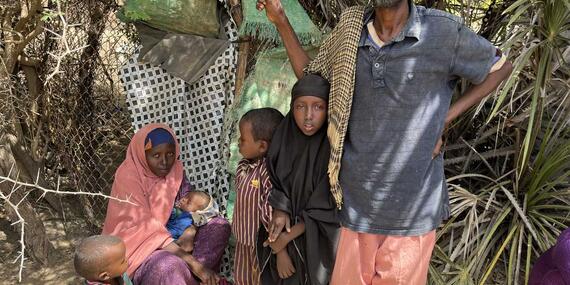Somalia: “I sold the last three goats; they were likely to die”

by Ayub Ahmed
Hussein was once the proud owner of some 200 goats in Turdo village, near Somalia’s Jamaame District. But the unprecedented drought that is ravaging Somalia claimed the animals one by one.
He sold his last three goats, and with the little money he had left, he and his wife and four children, including a three-week-old son, were forced to leave their village to find safety and assistance some 60 km away in Farwaamo village, in Somalia’s Lower Juba Region, in January.
Due to insecurity in the area, which is a result of the ongoing military operations against Al Shabaab, the family were unable to carry any of their possessions. "At the end, we fled with only the clothes on our backs,” said Hussein
On arrival in Farwaamo, the family sought shelter under a tree, which also protected them from Somalia’s scorching heat. “I will build a tent using sticks and old clothes or sheets with the help of people here,” he added.
Hussein and his family are now one of 400 displaced families (about 2,400 people) living in tents and makeshift shelters in Farwaamo village. Access to basic services is limited, and the families rely on small income from casual labour and relief organizations for survival. But the village has no bathrooms or sanitation facilities, which means the families are exposed to health risks.
According to Mohamed Sheikh, Head of the Jubaland Commission for Refugees and Internally Displaced Persons (JUCRI), the displaced people living in Farwaamo left their homes due to Somalia’s insecurity and its worst drought in 40 years. Up to 8.3 million people are expected to face crisis or worse levels of acute food insecurity between April and June.
When OCHA visited Farwaamo, JUCRI and Qatar Red Crescent were delivering food to the displaced families, each receiving 50 kg of wheat flour, 25 kg of rice, 10 kg of sugar, 5 litres of cooking oil, and dates and powdered milk.
Dreams despite difficulties
Like many displaced people, Hussein still has dreams, despite his current difficulties. Farwaamo village is near the Juba River, and in normal conditions it would be possible to farm along the riverbank. But that is now a difficult option due to the drought.
“The food I received will help me get by for some time, until I find a casual labour job on one of the neighbouring farms,” said Hussein, after receiving food assistance from JUCRI and Qatar Red Crescent.
Nearby, Maryan sat next to the food package she had just received. In November 2022, she fled Magaambo village in Jamaame District, in Lower Juba Region. She was a farmer there, but she lost her crops over three seasons due to low or no rainfall.
Since her husband died of an illness five years ago, Maryan has been the sole breadwinner for her five children. “I count on relief aid and support from relatives to survive,” she said.
Maryan hopes to return home and resume farming, if the rains come. “I miss home and my farm,” she added. “Before the drought, I was able to put food on the table, and my children went to school.”
Solutions for survival
Partners have increased humanitarian assistance in Lower Juba Region. The Qatar Red Crescent and Qatar Charity are targeting more than 4,500 families (about 27,000 people) with food assistance in the region.
The World Food Programme and local NGO Gargaar Relief Development Organization carried out a needs assessment to facilitate first-line response through food vouchers for newly displaced families in Farwaamo. Priority needs are food, water, shelter, health, and water, sanitation and hygiene services.
Partners are trucking water to several villages in the area, including Farwaamo, Buulo Gaduud and Yoontooy. UNHCR has provided 2,000 displaced families (about 12,000 people) living in the Kismayo area with emergency shelter kits and non-food items. The United Arab Emirates is also providing food assistance.
“People here need more urgent assistance,” said Sheikh. “Thanks to the donation from Qatar, today we can support about 350 families. However, the needs are huge, and more support is needed to provide water, basic health services, latrines and sanitation services.”
Life-saving assistance is critical, but it needs to be accompanied by investments in long-term solutions. As humanitarians focus on saving lives and averting famine in Somalia, there is a critical need to invest in livelihoods, resilience, infrastructure development, climate adaptation and durable solutions to ensure affected people can adapt and thrive.
